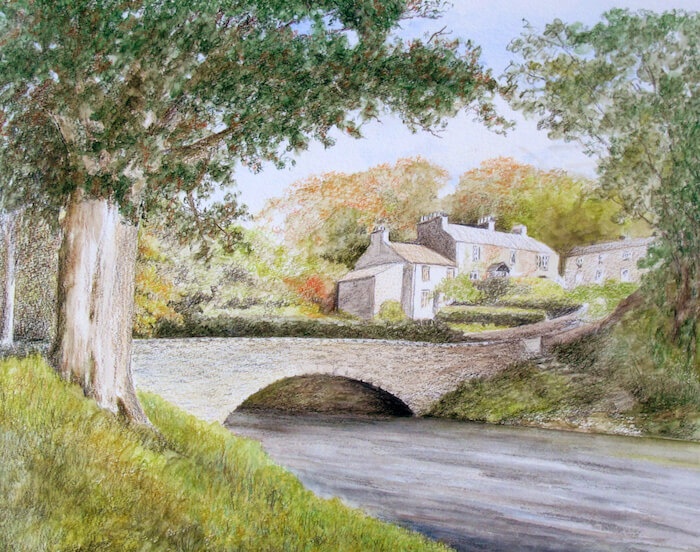- Home
- Beyond Basics
- Landscape drawing
Turn your own photo into a coloured pencil landscape with just your starter tin
Landscapes in coloured pencil can feel like “too much”: too many leaves, blades of grass, rocks, clouds… and a whole lot of green.
This page breaks that big scene into small, learnable parts so you can build one finished landscape from your own photo, using only the pencils in your starter tin.
Pick a photo you like, then use the sections below to practise each element - composition, light, trees, grass, sky, stone and water. Work through them and you’ll have the skills to redraw your photo as a coloured pencil landscape.
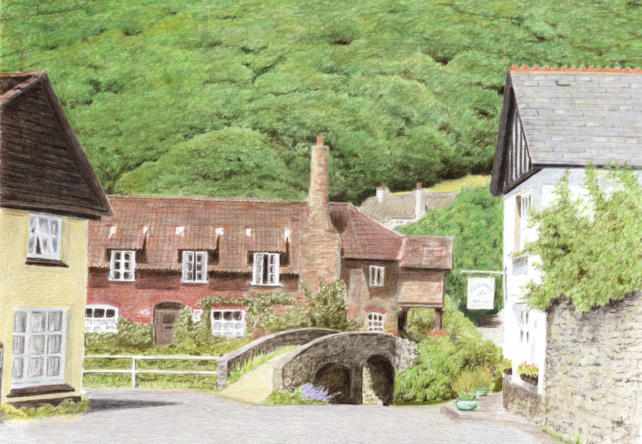
First steps: planning your scene
Start small. Before you touch colour, sketch a quick tonal thumbnail to sort out big shapes and composition.
Don’t chase every leaf or brick at this stage. Decide what fits in the frame, what you’ll leave out, and where your main focal point sits (usually where the lightest light meets the darkest dark, slightly off-centre).
You can do this outside or from a photo. If you use a photo, treat it as a starting point, not a prison - you can move or remove objects to improve the scene.
Your light source
Light tells the viewer what matters.
In rural scenes, light often comes from one main direction, softened by trees or hills. In town scenes, you might juggle street lamps, windows and signs, all casting different pools of light.
Notice where the light comes from and what colour it is: warm at sunrise and sunset, cooler under a clear blue sky.
If you want to go deeper into warm vs cool colours, head to our colour theory section, then come back here to apply it to your landscapes.
The elements of a coloured pencil landscape
Use the lessons below to tackle one part of your scene at a time.
Trees
Landscapes often include trees, and they can feel overwhelming if you try to draw every leaf.
Start with the overall shape of the tree (or mass of trees), not twigs. Our How to Draw Trees and Foliage page walks you through this.
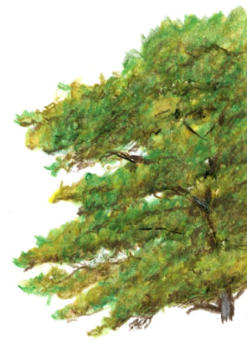 A watercolour pencil tree
A watercolour pencil treeThink in layers: trunk and main branches, then clumps of foliage that form a soft mass rather than a sharp outline. Use your eraser to pull out sky holes and soften the top edge so the tree doesn’t end in a hard line.
Season matters: spring needs light and olive greens, summer is deeper greens, autumn leans into yellows and browns, winter might show bare branches and even snow lifted out with an eraser.
We also have step-by-step workshops on a tree-covered hillside and a single tree drawn with watercolour pencils if you want to practise different approaches.
Grasses, weeds and flowers
Foreground grass is where a lot of beginners panic.
Start by blocking in the shadows dark enough to push the lighter blades forward. Vary your pencil pressure so your darks still have subtle colour shifts, not flat black bands.
Let grass overlap, bend and criss-cross. If every blade is the same height and direction, it will look like a green fence. Closer blades can cast shadows across those behind them, which adds depth.
Colours change with the season: summer grass often leans towards yellow-greens and browns rather than pure light and dark green.
Our Brokken Bridge tutorial (below) shows watercolour pencil techniques for foreground grass, and Peter’s Garden Archway shows how flowers can become the main focus in a more intimate scene.
Skies and clouds
Skies are more than “one blue”.
Look up and notice how the blue is usually deeper overhead and lighter near the horizon. Light, even pressure makes it easier to lift out clouds with an eraser so they have soft edges, not hard cut-outs.
A hint of shadow under the base of clouds tells us the sun isn’t hitting them directly - but go too dark and they’ll look heavy and stormy when you didn’t mean them to.
If you can, lie back and watch the clouds for a few minutes. Notice how their shapes change overhead versus near the horizon. That kind of observation feeds straight into your drawings.
For a deeper dive, see our background tutorial for layered watercolour pencil skies and our page on different ways to draw clouds.
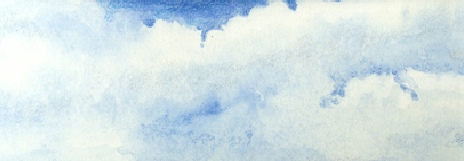 Clouds created with watercolour pencils
Clouds created with watercolour pencilsStone and brick
Rocks, walls and buildings give your landscape structure.
Use scribbled or broken strokes to suggest rough texture, but still pay attention to where the light hits and where the shadows fall. Wet stones after rain may need smoother, burnished layers to look shiny; in dry weather, let some paper texture show to suggest grit.
Our pages on brick and stone walls, plus our linear perspective guide, will help you avoid leaning buildings.
Perspective also plays a part when placing a roof on your buildings.
The Dartmoor Bowerman Stone tutorial shows how to combine rough rocks with softer fields and sky in one scene.
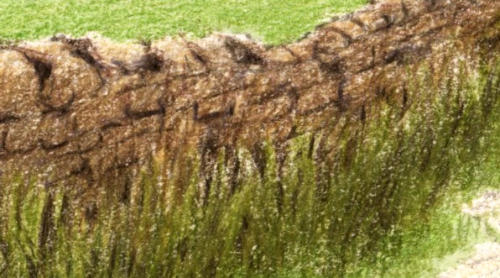 An enlargement of a dry stone wall drawing
An enlargement of a dry stone wall drawingWater
Rivers, ponds, lakes and sea all behave differently, but they share one rule: water reflects what’s around it, not just “blue”.
Calm water mirrors shapes and colours quite clearly; wind breaks those reflections into broken, shifting patterns. Look at your reference and copy the shapes of the reflections, not what you think “water” should look like.
If you’re struggling, turn your reference and drawing upside down so you only see abstract shapes and colours. This stops your brain from correcting things into “tree” or “boat” and helps you draw what’s really there.
We have a full page on reflections in water, plus a separate exercise on drawing boats with accurate proportions if you want to add them to your scene.
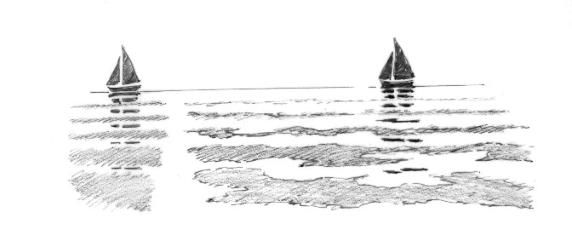 An illustration showing boat reflections
An illustration showing boat reflectionsWork through these sections with one favourite photo beside you. By the time you’ve tried each element, you’ll be ready to turn that photo into a finished coloured pencil landscape using just your starter tin.
Improve Your Pencil Art: Get Free Tips & Techniques
Sign up for our newsletter – just occasional emails packed with practical advice and inspiration for pencil artists like yourself
